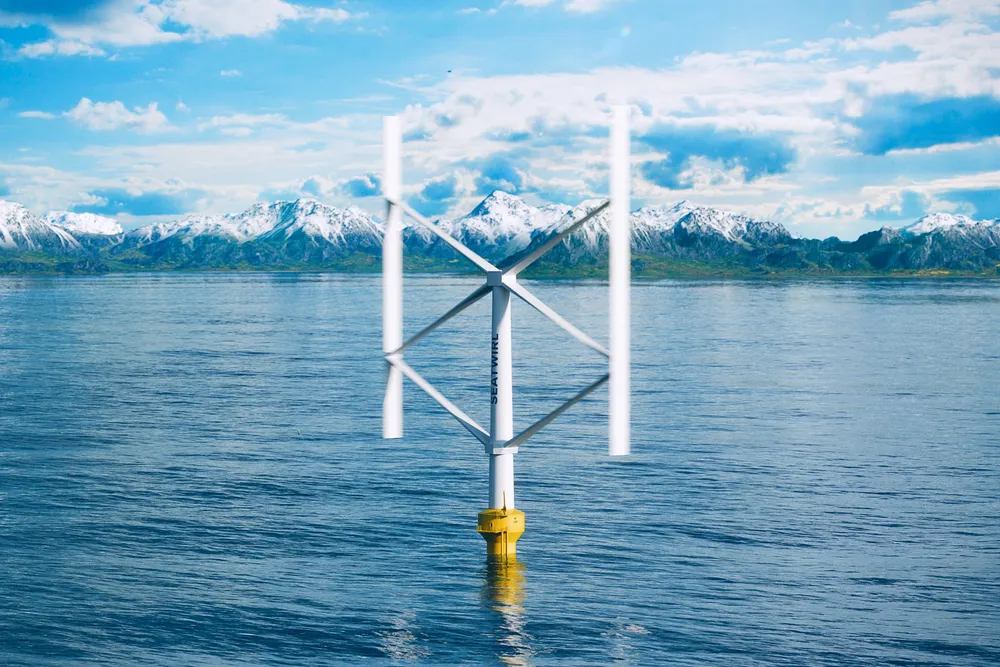EU-backed 'flat-packed' floating wind turbine could prove the doubters wrong
Yard managers will open crates and assemble integrated wind turbines akin to Ikea flat-packs, SeaTwirl boss says

Swedish innovator SeaTwirl has started work on a 2MW demonstrator project that will use a twin-blade version of its vertical-axis wind turbine (VAWT) technology in a way that allows a "flat-pack" approach to turbine assembly and integration, according to the company's chief executive.
SeaTwirl’s Verti-Go demonstrator project got the go-ahead after being selected under the hotly-disputed EU Horizon funding programme for innovative floating wind concepts.
With grant and consortium agreements now in place, the 18-month design and planning phase of the project started on 1 October, according to CEO Johan Sandberg.
SeaTwirl’s spar-based concept has a much lower center of gravity than conventional floating offshore wind solutions, where the turbine is typically mounted on a semi-submersible hull, or barge or a tension leg platform.
The turbine also rotates as a single integrated unit, with the entire VAWT, spar column and rotor. The rotating spar column transfers rotor weight to a floating structure which provides verticality through its own ballast.
This reduces bending forces and lowers steel requirements, according to Sandberg.
A nacelle situated close to the water surface allows access for standard service vessels to perform repair and maintenance.
A much slower rotational speed is expected to reduce blade erosion, storm impacts and avoid impacts on birds, while the absence of pitch and yaw is also expected to boost reliability, Sandberg said.
He points out that it was in 2022 — when the supply chain constraints, rising interest rates and surging commodity prices began raising doubts about the commercial viability of big floating wind projects — that he accepted an approach from SeaTwirl after a floating wind career with DNV and Aker Solutions.
"There were many dark clouds on the horizon for floating wind power and I thought that wasthe time to think out of the box and around disruptive innovation in floating wind," he recalls.
"I wanted to challenge this idea that scale is always the answer... I think we can offer something that doesn't require the thousand megawatt projects in order to be built," he added.
'Like oil platforms'
Other markets that have swung into view for SeaTwirl include the world of island communities
"We also see a big market in remote islands and, in July, we announced a big push for us in Canada, where there are a lot of small island communities, all of them running on diesel. They don't need 15 or 20 megawatt turbines, and they won't get them," he notes, describing the scaling as "like oil platforms".
"But if you add all of that up, it becomes a significant amount of capacity that may be needed there."
On the other hand, Sandberg stresses that the company is prepared to fight its corner for utility-scale projects in the "hundreds" of megawatts.
"If an company like Equinor comes out out says it cannot build a (500MW) floating wind farm with conventional turbines, then we can provide an option and we think we can do so with a lower cost of energy," he says.
To back up this this promise, SeaTwirl aims to facilitate fabrication, assembly and loadout with a new "flat-pack" approach to assembly, helped by the shift to a two-blade design was announced six months ago.
"The turbine has now become a two-dimensional structure, and this has major implications on how you build, commission and install the turbine," Sandberg says.
The approach requires little more than crawler cranes, a yard floor for assembly, and a loadout barge to take the turbine out to deeper waters for uprighting.
The company's three-blade prototype has been in the water since 2015 — twice as long as the design model — and will soon be decommissioned after achieving uninterrupted operations.
Horizon boost
The allocation of €15m ($18m) in Horizon funding has given a green light to a demonstrator project which will set out to verify all aspects of the technology, including more bespoke aspects, such as the main bearing.
Overall, Sandberg stresses that the design aims to use multiple and standardised components, with some element of redundancy in its three generators and three gearboxes.
After validation and optimisation of the design, the consortium will proceed to the final investment decision and then another 15-month stage, consisting of procurement, fabrication and commissioning of the turbine.
The test site for the operational period— also 15 months — is likely to be decided at the kick-off meeting later this month, with Norway's MetCentre one of the candidates.
"I think the fact that the EU chose SeaTwirl as one of the concepts to be developed is great recognition of the potential of the technology. We have received huge interest from all over the world," Sandberg says.
(Copyright)